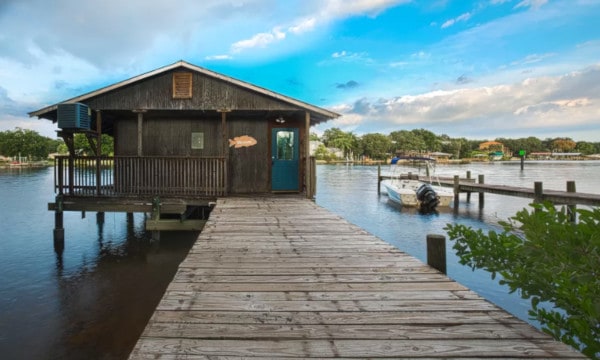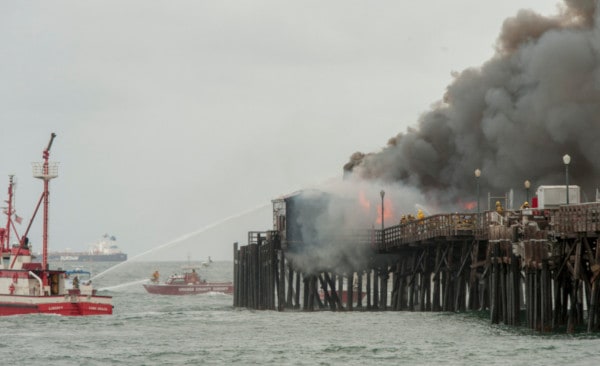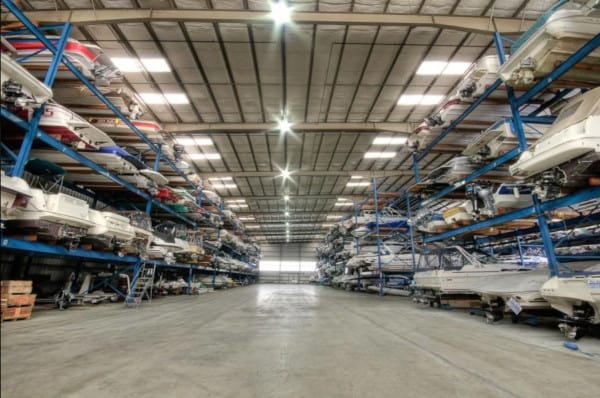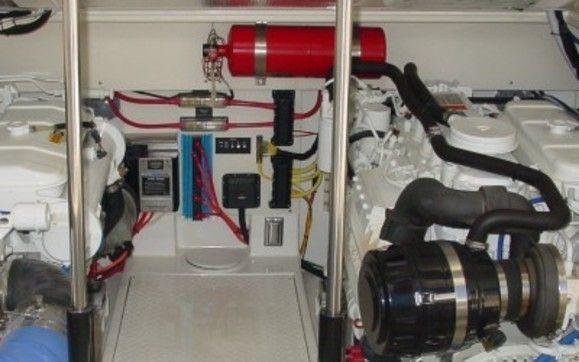Learn the marine fire protection requirements in NFPA 1, NFPA 303, and NFPA 307
Superyachts are the playgrounds of the world’s wealthiest individuals. These vessels, which often cost hundreds of millions of dollars, can come equipped with everything from helicopters, multiple swimming pools, and basketball courts to concert halls and submarines. It’s fair to say that the owners (and the owners’ insurance companies) would be a little upset if a vessel were lost to fire.
But whether you pilot a superyacht around the world or take your Mako skiff to your favorite fishing spot, you want to be sure that your boat is safely stored, protected, and ready to go. Fortunately, model fire codes and standards offer guidance on the proper protection of the facilities that house marine vessels.
The fire protection requirements for marinas, docks, and boathouses begin with NFPA 1: Fire Code. This document references and points readers to more specific guidance in NFPA 303: Fire Protection Standard for Marinas and Boatyards and NFPA 307: Standard for the Construction and Fire Protection of Marine Terminals, Piers, and Wharves.
Though they are not enforceable for vessels that are housed at private and single-family dwellings, it is important to know these requirements—especially if the boat will be stored at a separate facility. Boat owners will want to walk the property to check for the presence of these fire protection features and facility managers should apply these principles to protect their facility.
These documents address fire protection requirements for four distinct marine occupancy areas:
- Boathouses
- Piers
- Indoor rack storage
- Berthing
It is important to note that fire extinguishers are required throughout all of these categories, and NFPA documents include specific fire extinguisher type and location instructions based on the hazards that can be expected. All fire extinguishers must be installed, serviced, and maintained per NFPA 10: Standard for Portable Fire Extinguishers.

Marine fire protection for boathouses and other buildings on piers
Boathouses and other structures do not need additional fire protection systems beyond fire extinguishers until a structure is larger than 500 square feet. When the building exceeds this size, an automatic fire sprinkler system is required.
There is an exception, however: no fire sprinklers are needed if the building is of Type I or Type II construction and it is not housing combustible contents. Type I and Type II structures built with materials such as concrete and steel are considered “non-combustible” and “fire-resistive.” Additionally, the local authority having jurisdiction (AHJ) can approve the omission of an automatic fire sprinkler system.
When a structure exceeds 5,000 sq. ft., it is required to have a fire sprinkler system installed regardless of construction type—unless an AHJ permits the omission of sprinklers based on certain factors:
From the 2018 edition of NFPA 1
28.1.2.2.1.3* Existing facilities shall not be required to be protected by an automatic fire-extinguishing system where acceptable to the AHJ. [303:6.3.3.4]
A.28.1.2.2.1.3 Where clearly impractical for economic or physical reasons, the AHJ could permit the omission of an automatic fire-extinguishing system when considering water supply availability and adequacy and size of facility. [NFPA 303: A.6.3.1.3]
Marine fire protection for piers
Non-combustible piers do not require specific fire protection systems. A combustible pier, however, must be protected with an automatic fire sprinkler system installed following NFPA 13: Standard for the Installation of Sprinkler Systems and the special requirements outlined in section 4.3 of NFPA 307, if it meets the following criteria:
- Exceeds 25 feet in width
- Exceeds 5,000 square feet in area
- Is within 30 feet of other structures that are required to be protected
- Where the distance from the water surface to the underside of the pier exceeds 36 inches
If the hose-lay distance from a fire apparatus to the pier is greater than 150 feet, then a Class I standpipe system is also required. However, the code does not require the installation of onsite hoses, hose racks, or standpipe cabinets.
Piers that extend more than 25 feet from land must be equipped with a fire extinguisher. The extinguishers must:
- Be listed for use on Class A, B, and C fires.
- Be protected from the elements (with cabinets or covers).
- Be placed within 75 feet of travel distance from any spot.
When there is a fuel-dispensing area on the pier, it should have fire extinguishers listed for extra (high) hazard locations installed on each side of the fueling area. All other extinguishers on the pier can be rated for an ordinary (moderate) hazard.
From the 2018 edition of NFPA 10
5.4 Classification of Hazards.
5.4.1.2* Ordinary Hazard. Ordinary hazard occupancies shall be classified as locations where the quantity and combustibility of Class A combustible materials and Class B flammables are moderate and fires with moderate rates of heat release are expected. These occupancies consist of fire hazards that only occasionally contain Class A combustible materials beyond normal anticipated furnishings, and/or the total quantity of Class B flammables typically expected to be present is from 1 gal to 5 gal (3.8 L to 18.9 L) in any room or area.
5.4.1.3* Extra Hazard. Extra hazard occupancies shall be classified as locations where the quantity and combustibility of Class A combustible material are high or where high amounts of Class B flammables are present and rapidly developing fires with high rates of heat release are expected. These occupancies consist of fire hazards involved with the storage, packaging, handling, or manufacture of Class A combustibles, and/or the total quantity of Class B flammables expected to be present is more than 5 gal (18.9 L) in any room or area.

Indoor rack storage facilities usually need sprinklers
Structures in which boats are stored on racks inside of a building must have an automatic fire sprinkler system. An accessible, reliable, and approved water supply and a fire hydrant must be within 100 feet of the building. Class I standpipes must be installed, and the hose nozzles need to be capable of reaching the highest level of boat storage.
There is one exception: The automatic fire sprinkler system may be eliminated in buildings that do not exceed 5,000 square feet if the building has a monitored fire alarm system that is compliant with NFPA 72: National Fire Alarm and Signaling Code, or a full-time fire watch service is provided.

Fire protection in wet storage and berthing areas center around accessibility
Ft. Lauderdale recently suffered the largest fire loss in the city’s history (in terms of property damage), when a fire originating on one yacht spread to an adjacent yacht. The combined value of these vessels exceeded $20 million. Sixteen boats were also destroyed or damaged at a marina in South Carolina. In another fire in Venice, Florida two yachts and two other vessels sustained about $1 million worth of damage.
From these stories and many others like it, it’s easy to see why the primary fire protection feature of berthing areas is the ability to quickly and individually access and move vessels.
From the 2018 edition of NFPA 1
28.1.3.1 Wet Storage and Berthing.
28.1.3.1.1 Each berth shall be arranged such that a boat occupying the berth can be removed in an emergency without the necessity of moving other boats. [NFPA 303: 7.1.1]
Fire detection devices are required in any marine facility that does not have sprinklers—and the Coast Guard covers onboard fire protection
Fire detection devices must be installed in all structures and covered areas that do not have the protection of an automatic fire sprinkler system. These devices, such as smoke or heat detectors, are required throughout all hazardous locations including storage areas for combustibles, flammables, paint, and batteries; covered vessel maintenance and storage spaces; laundry and furnace rooms; kitchens; and areas used for dining or lodging.
Onboard fire protection requirements are the sole domain of the United States Coast Guard. These requirements may include fixed fire suppression systems for engine areas, varying numbers of fire extinguishers on all vessels, and complete automatic fire sprinkler systems for larger vessels.

Boat owners and docking, storage, and berthing facility owners are responsible for ensuring marine fire protection
If you are a boat owner, make sure that both your vessel and any facility it is housed in have adequate fire protection measures. And a similar responsibility applies to dock masters, estate managers, and other marine facility managers.
Following these guidelines and inspecting facilities to make sure the right fire protection features are in place will help ensure that vessels remain protected … from fires that can quickly spiral out of control in areas packed with boats and fuel.
If you need marine fire protection equipment, QRFS carries fire extinguishers, extinguisher cabinets and covers, firehose assemblies for standpipe systems, fire sprinklers, and a range of other items, tools, and system components.
If you have any questions or need help finding an item, call us at +1 (888) 361-6662 or email support@qrfs.com.
This blog was originally posted at blog.qrfs.com. Check us out at Facebook.com/QuickResponseFireSupply or on Twitter @QuickResponseFS.


